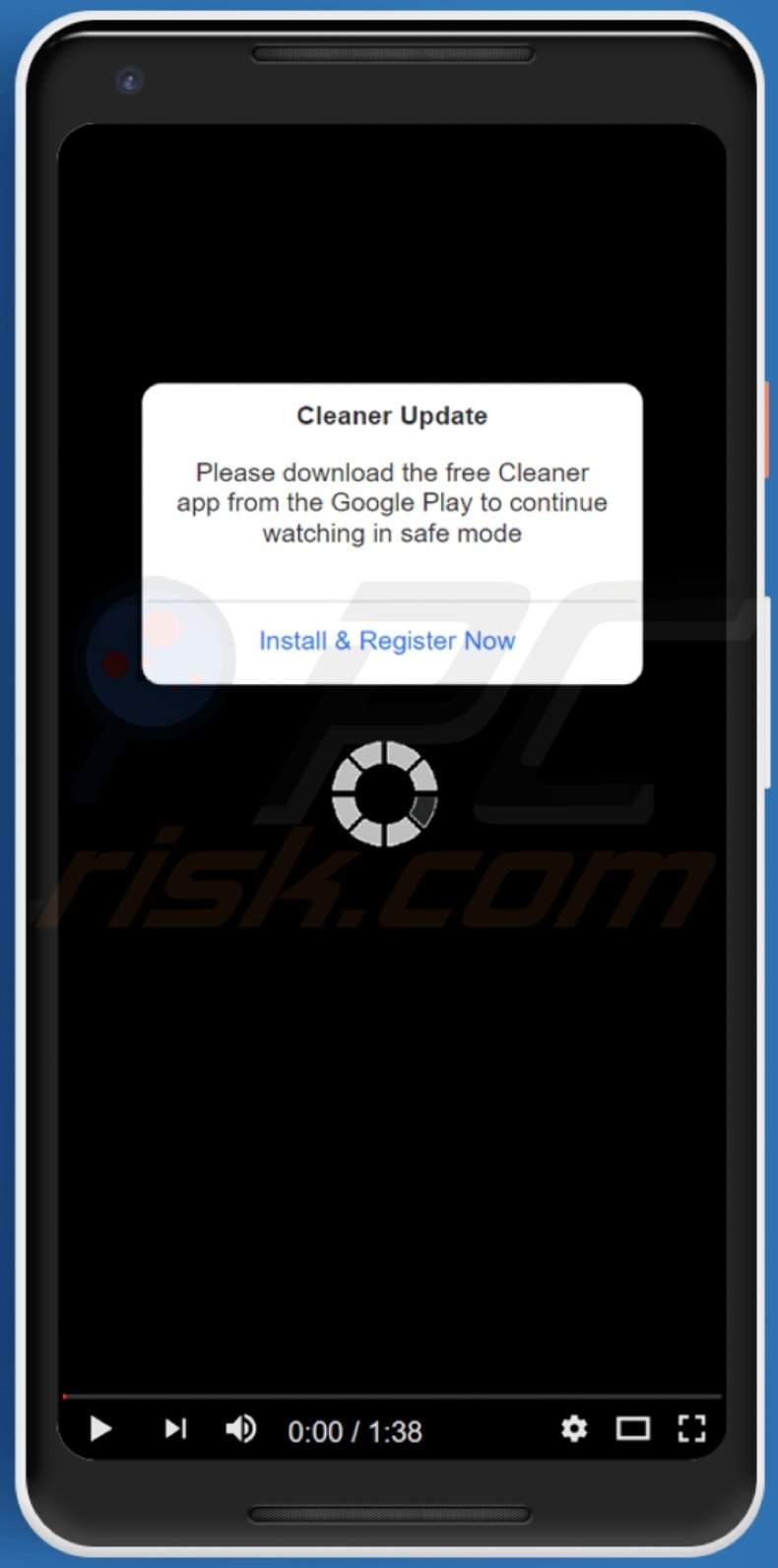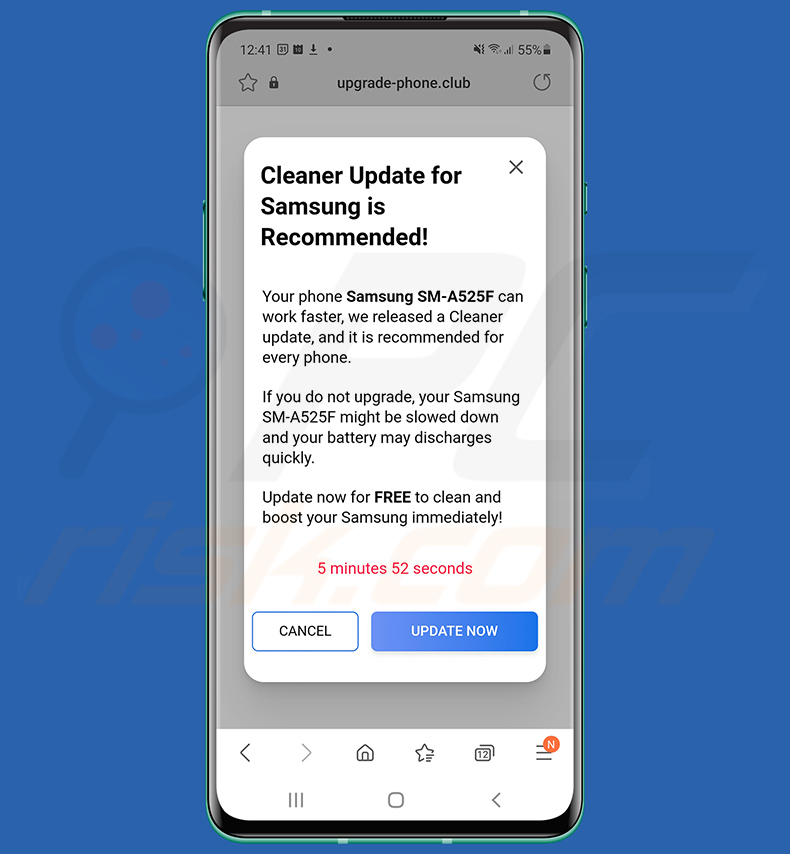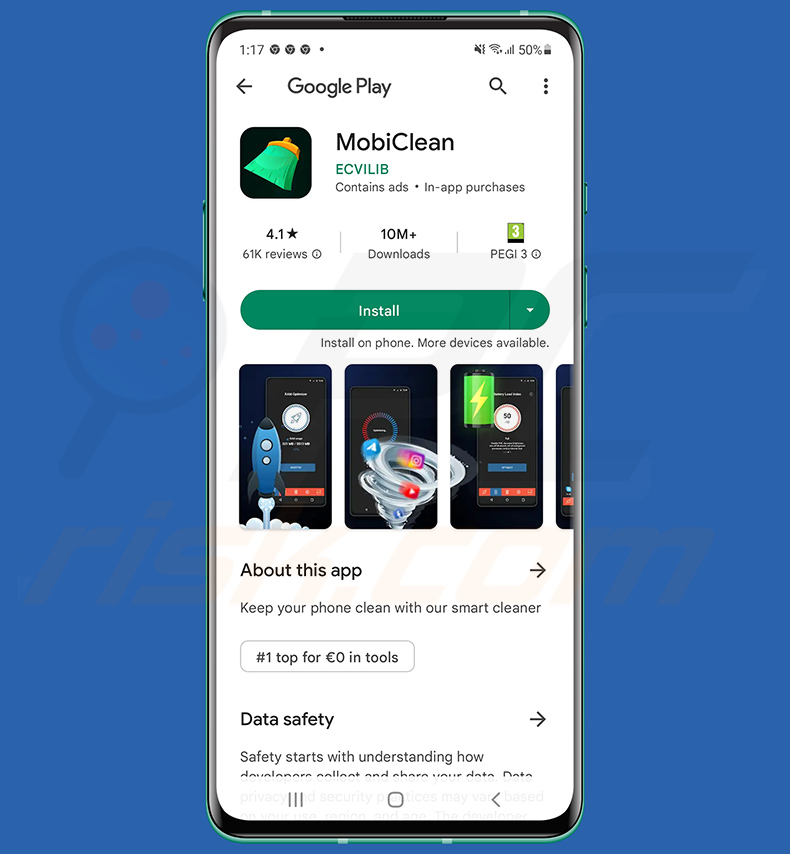How to recognize scams like the Cleaner Update pop-up scam?
Phishing/ScamAlso Known As: Cleaner Update pop-up
Get free scan and check if your device is infected.
Remove it nowTo use full-featured product, you have to purchase a license for Combo Cleaner. Seven days free trial available. Combo Cleaner is owned and operated by RCS LT, the parent company of PCRisk.com.
What is the Cleaner Update scam?
It is the name of a scam targeting Android users. The scheme is promoted on various deceptive websites. It attempts to trick users into downloading/installing and/or purchasing dubious software by claiming that it is necessary to continue watching online content in "safe mode".

Cleaner Update pop-up scam in detail
When a website running the "Cleaner Update" scam is accessed, it presents visitors with a pop-up window that contains a brief message. The text in the pop-up states that a new update for the visitor's cleaner software is available.
The scheme then requests the user to download a "free Cleaner app" in order to continue watching (online content) in "safe mode". It must be emphasized that the claims made by "Cleaner Update" are false. Therefore, installing the software promoted through such schemes can result in a wide variety of issues.
Scams of this kind typically endorse fake anti-viruses, adware, browser hijackers, and other PUAs (Potentially Unwanted Applications). However, the schemes may proliferate trojans, ransomware, cryptocurrency miners, and other malware as well.
It is noteworthy that users seldom access untrustworthy sites intentionally. Most enter them via mistyped URLs, or redirects caused by rogue pages, intrusive advertisements, or installed PUAs.
More information about potentially unwanted applications
As mentioned in the introduction, deceptive sites like those running the "Cleaner Update" scam usually promote various PUAs. This software appears legitimate and harmless. Unwanted apps lure users with promises of "useful" and "advantageous" functionalities, which are seldom operational.
Fake anti-virus tools are a prime example of this type; they require activation (i.e., purchase) to perform the advertised features, yet after activation - they remain nonoperational.
Furthermore, PUAs typically have harmful abilities. Some of these applications can force-open unreliable and malicious websites. Adware-types run intrusive advertisement campaigns. When clicked on, the delivered adverts redirect to untrustworthy/dangerous webpages, and some can stealthily download/install software.
Browser hijackers modify browser settings to promote fake search engines. These web searchers are rarely able to provide search results, so they redirect to Google, Yahoo, Bing, and other genuine search engines.
What is more, most PUAs (regardless of type) have data tracking functionalities. Information of interest includes: URLs visited, pages viewed, search queries typed, IP addresses/ geolocations, personally identifiable details, finance-related data, and so forth. The collected data is monetized by being shared with and/or sold to third-parties.
In summary, the presence of unwanted apps on devices can result in system infections, severe privacy issues, financial losses, and even identity theft. To ensure device integrity and user privacy, all suspicious applications and browser extensions/plug-ins must be removed immediately upon detection.
| Name | Cleaner Update pop-up |
| Threat Type | Android malware, malicious application, unwanted application. |
| Related Domains | glbltraffic[.]com |
| Detection Names | Forcepoint ThreatSeeker (Suspicious), Full List (VirusTotal) |
| Symptoms | The device is running slow, system settings are modified without user's permission, questionable applications appear, data and battery usage is increased significantly, browsers redirect to questionable websites, intrusive advertisements are delivered. |
| Distribution methods | Infected email attachments, malicious online advertisements, social engineering, deceptive applications, scam websites. |
| Damage | Stolen personal information (private messages, logins/passwords, etc.), decreased device performance, battery is drained quickly, decreased Internet speed, huge data losses, monetary losses, stolen identity (malicious apps might abuse communication apps). |
| Malware Removal (Windows) |
To eliminate possible malware infections, scan your computer with legitimate antivirus software. Our security researchers recommend using Combo Cleaner. Download Combo CleanerTo use full-featured product, you have to purchase a license for Combo Cleaner. 7 days free trial available. Combo Cleaner is owned and operated by RCS LT, the parent company of PCRisk.com. |
Online scams in general
"Cleanup required right now!" and "Your chrome Device may be too old" are a couple examples of Android-targeting scams. Popular scam models include (but are not limited to): alerts that a piece of essential software is outdated or missing, warnings that the device is infected or at risk, fake prize giveaways, and ludicrous deals.
The Internet is rife with misleading, deceptive, and even malicious content. Due to the prevalence of online scams, it is strongly recommended to exercise caution when browsing.
How did potentially unwanted applications install on my computer?
Some PUAs have "official" promotional/download sites, which are often pushed by deceptive/scam ones. These applications are also spread via intrusive advertisements. Once clicked on, the ads can execute scripts to make stealthy downloads/installations.
PUAs are most commonly distributed through downloaders/installers of other programs. "Bundling" is the name of this false marketing technique - packing regular software with unwanted or malicious additions. Rushed downloads/installations (e.g., skipped steps, etc.) increase the risk of allowing bundled content into the device.
How to avoid installation of potentially unwanted applications?
It is advised to research software before download/installation. Additionally, all downloads must be performed from official and verified sources. Untrustworthy download channels, e.g., unofficial and free file-hosting sites, Peer-to-Peer sharing networks, and other third-party downloaders - often offer bundled and hazardous content.
When downloading/installing, it is recommended to read terms, study available options, use the "Custom/Advanced" settings to opt-out from additional apps, features, etc. Intrusive ads appear legitimate; however, they redirect to highly questionable websites (e.g., gambling, pornography, adult-dating, and so on).
In case of encounters with advertisements and/or redirects of this kind, the device must be checked and all suspect applications and browser extensions/plug-ins detected - removed from it without delay.
Text presented in the "Cleaner Update" scam pop-up window:
Cleaner Update
Please download the free Cleaner app from the Google Play to continue watching in safe mode
Install & Register Now
0:00 / 1:38
Another example of Cleaner Update-themed pop-up scam:

Text presented within:
Cleaner Update for Samsung is Recommended!
Your phone Samsung SM-A525F can work faster, we released a Cleaner update, and it is recommended for every phone.
If you do not upgrade, your Samsung SM-A525F might be slowed down and your battery may discharges quickly.
Update now for FREE to clean and boost your Samsung immediately!
[CANCEL] [UPDATE NOW]
Screenshot of the application (MobiClean) promoted via this scam:

Quick menu:
- Introduction
- How to delete browsing history from the Chrome web browser?
- How to disable browser notifications in the Chrome web browser?
- How to reset the Chrome web browser?
- How to delete browsing history from the Firefox web browser?
- How to disable browser notifications in the Firefox web browser?
- How to reset the Firefox web browser?
- How to uninstall potentially unwanted and/or malicious applications?
- How to boot the Android device in "Safe Mode"?
- How to check the battery usage of various applications?
- How to check the data usage of various applications?
- How to install the latest software updates?
- How to reset the system to its default state?
- How to disable applications that have administrator privileges?
Delete browsing history from the Chrome web browser:

Tap the "Menu" button (three dots on the right-upper corner of the screen) and select "History" in the opened dropdown menu.

Tap "Clear browsing data", select "ADVANCED" tab, choose the time range and data types you want to delete and tap "Clear data".
Disable browser notifications in the Chrome web browser:

Tap the "Menu" button (three dots on the right-upper corner of the screen) and select "Settings" in the opened dropdown menu.

Scroll down until you see "Site settings" option and tap it. Scroll down until you see "Notifications" option and tap it.

Find the websites that deliver browser notifications, tap on them and click "Clear & reset". This will remove permissions granted for these websites to deliver notifications. However, once you visit the same site again, it may ask for a permission again. You can choose whether to give these permissions or not (if you choose to decline the website will go to "Blocked" section and will no longer ask you for the permission).
Reset the Chrome web browser:

Go to "Settings", scroll down until you see "Apps" and tap it.

Scroll down until you find "Chrome" application, select it and tap "Storage" option.

Tap "MANAGE STORAGE", then "CLEAR ALL DATA" and confirm the action by taping "OK". Note that resetting the browser will eliminate all data stored within. This means that all saved logins/passwords, browsing history, non-default settings and other data will be deleted. You will also have to re-login into all websites as well.
Delete browsing history from the Firefox web browser:

Tap the "Menu" button (three dots on the right-upper corner of the screen) and select "History" in the opened dropdown menu.

Scroll down until you see "Clear private data" and tap it. Select data types you want to remove and tap "CLEAR DATA".
Disable browser notifications in the Firefox web browser:

Visit the website that is delivering browser notifications, tap the icon displayed on the left of URL bar (the icon will not necessarily be a "Lock") and select "Edit Site Settings".

In the opened pop-up opt-in the "Notifications" option and tap "CLEAR".
Reset the Firefox web browser:

Go to "Settings", scroll down until you see "Apps" and tap it.

Scroll down until you find "Firefox" application, select it and tap "Storage" option.

Tap "CLEAR DATA" and confirm the action by taping "DELETE". Note that resetting the browser will eliminate all data stored within. This means that all saved logins/passwords, browsing history, non-default settings and other data will be deleted. You will also have to re-login into all websites as well.
Uninstall potentially unwanted and/or malicious applications:

Go to "Settings", scroll down until you see "Apps" and tap it.

Scroll down until you see a potentially unwanted and/or malicious application, select it and tap "Uninstall". If, for some reason, you are unable to remove the selected app (e.g., you are prompted with an error message), you should try using the "Safe Mode".
Boot the Android device in "Safe Mode":
The "Safe Mode" in Android operating system temporarily disables all third-party applications from running. Using this mode is a good way to diagnose and solve various issues (e.g., remove malicious applications that prevent users you from doing so when the device is running "normally").

Push the "Power" button and hold it until you see the "Power off" screen. Tap the "Power off" icon and hold it. After a few seconds the "Safe Mode" option will appear and you'll be able run it by restarting the device.
Check the battery usage of various applications:

Go to "Settings", scroll down until you see "Device maintenance" and tap it.

Tap "Battery" and check the usage of each application. Legitimate/genuine applications are designed to use as low energy as possible in order to provide the best user experience and to save power. Therefore, high battery usage may indicate that the application is malicious.
Check the data usage of various applications:

Go to "Settings", scroll down until you see "Connections" and tap it.

Scroll down until you see "Data usage" and select this option. As with battery, legitimate/genuine applications are designed to minimize data usage as much as possible. This means that huge data usage may indicate presence of malicious application. Note that some malicious applications might be designed to operate when the device is connected to wireless network only. For this reason, you should check both Mobile and Wi-Fi data usage.

If you find an application that uses a lot of data even though you never use it, then we strongly advise you to uninstall it as soon as possible.
Install the latest software updates:
Keeping the software up-to-date is a good practice when it comes to device safety. The device manufacturers are continually releasing various security patches and Android updates in order to fix errors and bugs that can be abused by cyber criminals. An outdated system is way more vulnerable, which is why you should always be sure that your device's software is up-to-date.

Go to "Settings", scroll down until you see "Software update" and tap it.

Tap "Download updates manually" and check if there are any updates available. If so, install them immediately. We also recommend to enable the "Download updates automatically" option - it will enable the system to notify you once an update is released and/or install it automatically.
Reset the system to its default state:
Performing a "Factory Reset" is a good way to remove all unwanted applications, restore system's settings to default and clean the device in general. However, you must keep in mind that all data within the device will be deleted, including photos, video/audio files, phone numbers (stored within the device, not the SIM card), SMS messages, and so forth. In other words, the device will be restored to its primal state.
You can also restore the basic system settings and/or simply network settings as well.

Go to "Settings", scroll down until you see "About phone" and tap it.

Scroll down until you see "Reset" and tap it. Now choose the action you want to perform:
"Reset settings" - restore all system settings to default;
"Reset network settings" - restore all network-related settings to default;
"Factory data reset" - reset the entire system and completely delete all stored data;
Disable applications that have administrator privileges:
If a malicious application gets administrator-level privileges it can seriously damage the system. To keep the device as safe as possible you should always check what apps have such privileges and disable the ones that shouldn't.

Go to "Settings", scroll down until you see "Lock screen and security" and tap it.

Scroll down until you see "Other security settings", tap it and then tap "Device admin apps".

Identify applications that should not have administrator privileges, tap them and then tap "DEACTIVATE".
Frequently Asked Questions (FAQ)
What is a pop-up scam?
A pop-up scam is a deceptive message (usually a virus or error alert) claiming that users need to remove malware, fix certain errors or perform other actions to protect/fix their devices.
What is the purpose of a pop-up scam?
Most pop-up scams are used to distribute malicious software, extract sensitive information (for example, credit card details, account login credentials), promote questionable software.
Why do I encounter fake pop-ups?
These scams usually are delivered by untrustworthy (deceptive, potentially malicious) websites. Users end up on such pages through shady ads or pages using questionable advertising networks. They rarely are opened on purpose.
Share:

Tomas Meskauskas
Expert security researcher, professional malware analyst
I am passionate about computer security and technology. I have an experience of over 10 years working in various companies related to computer technical issue solving and Internet security. I have been working as an author and editor for pcrisk.com since 2010. Follow me on Twitter and LinkedIn to stay informed about the latest online security threats.
PCrisk security portal is brought by a company RCS LT.
Joined forces of security researchers help educate computer users about the latest online security threats. More information about the company RCS LT.
Our malware removal guides are free. However, if you want to support us you can send us a donation.
DonatePCrisk security portal is brought by a company RCS LT.
Joined forces of security researchers help educate computer users about the latest online security threats. More information about the company RCS LT.
Our malware removal guides are free. However, if you want to support us you can send us a donation.
Donate
▼ Show Discussion